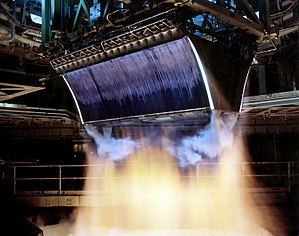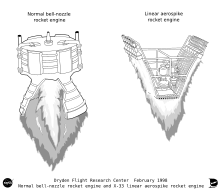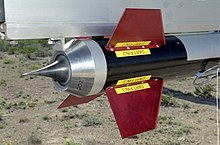사용자:Yunsoo9825/연습장
이곳은 Yunsoo9825의 사용자 연습장으로, 사용자 문서 아래에 위치합니다. 이곳은 위키 문법 연습 및 문서 발전을 위한 공간입니다. |

에어로스파이크 엔진은 광범위한 고도에 걸쳐 공기역학적 효율을 유지하는 로켓 엔진의 한 형태이다. 이 엔진은 고도 보상 노즐 엔진 종류의 구성원입니다. 에어로스파이크 엔진을 탑재한 발사체는 추력이 가장 많이 필요한 저고도에서 25~30% 적은 연료를 사용한다. Aerospike engines have been studied for a number of years and are the baseline engines for many single-stage-to-orbit (SSTO) designs and were also a strong contender for the Space Shuttle Main Engine. However, no such engine is in commercial production, although some large-scale aerospikes are in testing phases.[1]
The terminology in the literature surrounding this subject is somewhat confused—the term aerospike was originally used for a truncated plug nozzle with a very rough conical taper and some gas injection, forming an "air spike" to help make up for the absence of the plug tail. However, frequently, a full-length plug nozzle is now called an aerospike.
Principles
[편집]The basic concept of any engine bell is to efficiently expand the flow of exhaust gases from the rocket engine into one direction. The exhaust, a high-temperature mix of gases, has an effectively random momentum distribution, and if it is allowed to escape in that form, only a small part of the flow will be moving in the correct direction to contribute to forward thrust.

Instead of firing the exhaust out of a small hole in the middle of a bell, an aerospike engine avoids this random distribution by firing along the outside edge of a wedge-shaped protrusion, the "spike". The spike forms one side of a virtual bell, with the other side being formed by the outside air—thus the "aerospike".
The idea behind the aerospike design is that at low altitude the ambient pressure compresses the wake against the nozzle. The recirculation in the base zone of the wedge can then raise the pressure there to near ambient. Since the pressure on top of the engine is ambient, this means that base gives no overall thrust (but it also means that this part of the nozzle doesn't lose thrust by forming a partial vacuum, thus the base part of the nozzle can be ignored at low altitude).
As the spacecraft climbs to higher altitudes, the air pressure holding the exhaust against the spike decreases, but the pressure on top of the engine decreases at the same time, so this is not detrimental. Further, although the base pressure drops, the recirculation zone keeps the pressure on the base up to a fraction of 1 bar, a pressure that is not balanced by the near vacuum on top of the engine; this difference in pressure gives extra thrust at altitude, contributing to the altitude compensating effect. This produces an effect like that of a bell that grows larger as air pressure falls, providing altitude compensation.
The disadvantages of aerospikes seem to be extra weight for the spike, and increased cooling requirements due to the extra heated area. Furthermore, the larger cooled area can reduce performance below theoretical levels by reducing the pressure against the nozzle. Also, aerospikes work relatively poorly between Mach 1-3, where the airflow around the vehicle has reduced pressure, and this reduces the thrust.[2]
Variations
[편집]Several versions of the design exist, differentiated by their shapes. In the toroidal aerospike the spike is bowl-shaped with the exhaust exiting in a ring around the outer rim. In theory this requires an infinitely long spike for best efficiency, but by blowing a small amount of gas out the center of a shorter truncated spike, something similar can be achieved.
In the linear aerospike the spike consists of a tapered wedge-shaped plate, with exhaust exiting on either side at the "thick" end. This design has the advantage of being stackable, allowing several smaller engines to be placed in a row to make one larger engine while augmenting steering performance with the use of individual engine throttle control.
Performance
[편집]Rocketdyne conducted a lengthy series of tests in the 1960s on various designs. Later models of these engines were based on their highly reliable J-2 engine machinery and provided the same sort of thrust levels as the conventional engines they were based on; 200,000 lbf (890 kN) in the J-2T-200k, and 250,000 lbf (1.1 MN) in the J-2T-250k (the T refers to the toroidal combustion chamber). Thirty years later their work was dusted off again for use in NASA's X-33 project. In this case the slightly upgraded J-2S engine machinery was used with a linear spike, creating the XRS-2200. After more development and considerable testing, this project was cancelled when the X-33's composite fuel tanks repeatedly failed.

Three XRS-2200 engines were built during the X-33 program and underwent testing at NASA's Stennis Space Center. The single-engine tests were a success, but the program was halted before the testing for the 2-engine setup could be completed. The XRS-2200 produces 204,420 lbf (909,300 N) thrust with an Isp of 339 seconds at sea level, and 266,230 lbf (1,184,300 N) thrust with an Isp of 436.5 seconds in a vacuum.
The RS-2200 Linear Aerospike Engine[3] was derived from the XRS-2200. The RS-2200 was to power the VentureStar single-stage-to-orbit vehicle. In the latest design, seven RS-2200s producing 542,000 pounds of thrust each would boost the VentureStar into low earth orbit. The development on the RS-2200 was formally halted in early 2001 when the X-33 program did not receive Space Launch Initiative funding. Lockheed Martin chose to not continue the VentureStar program without any funding support from NASA. An engine of this type is on outdoor display on the grounds of the NASA Marshall Space Flight Center in Huntsville Alabama.

Although the cancelling of the X-33 program was a setback for aerospike engineering, it is not the end of the story. A milestone was achieved when a joint academic/industry team from California State University, Long Beach (CSULB) and Garvey Spacecraft Corporation successfully conducted a flight test of a liquid-propellant powered aerospike engine in the Mojave Desert on September 20, 2003. CSULB students had developed their Prospector 2 (P-2) rocket using a 1,000 lbf (4.4 kN) LOX/ethanol aerospike engine. This work on aerospike engines continues; Prospector-10, a ten-chamber aerospike engine, was test-fired June 25, 2008.[4]
Further progress came in March 2004 when two successful tests were carried out at the NASA Dryden Flight Research Centre using small-scale rockets manufactured by Blacksky Corporation, based in Carlsbad, California. The aerospike nozzles and solid rocket motors were developed and built by the rocket motor division of Cesaroni Technology Incorporated, north of Toronto, Ontario. The two rockets were solid-fuel powered and fitted with non-truncated toroidal aerospike nozzles. They reached apogees of 26,000 ft (7,900 m) and speeds of about Mach 1.5.
Small-scale aerospike engine development using a hybrid rocket propellant configuration has been ongoing by members of the Reaction Research Society.
See also
[편집]References
[편집]External links
[편집]- Aerospike Engine
- Advanced Engines planned for uprated Saturn and Nova boosters — includes the J-2T
- Linear Aerospike Engine — Propulsion for the X-33 Vehicle
- Dryden Flight Research Centre
- Aerospike Engine Control System Features And Performance
- X-33 Attitude Control Using The XRS-2200 Linear Aerospike Engine
